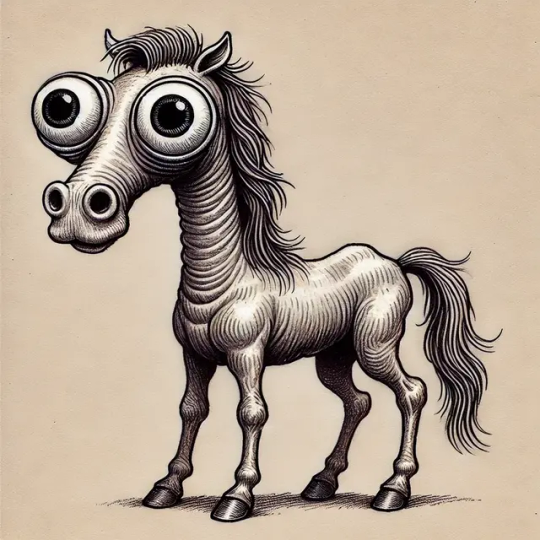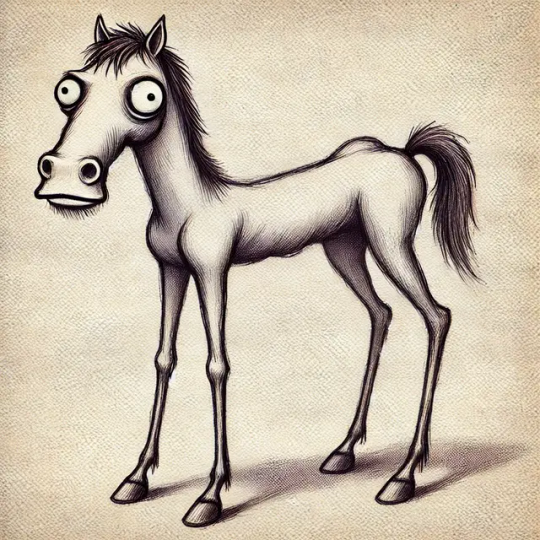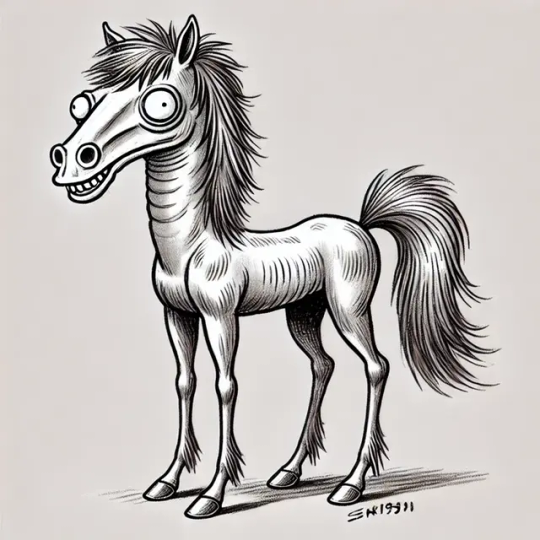#FunnyArtFails
Explore tagged Tumblr posts
Text
Good Drawings of Bad Horses: The Art of Failing Gracefully
Good Drawings of Bad Horses: The Art of Failing Gracefully

Horse drawings hold a special place in the history of art. Since the earliest cave paintings, humans have been obsessed with capturing the power, grace, and elegance of these majestic creatures. However, drawing horses well is notoriously difficult. Their anatomy is complex, their proportions demand precision, and even slight miscalculations can turn an otherwise beautiful sketch into an unintentional comedy masterpiece.
And yet, there is something delightfully charming about good drawings of bad horses. Whether it's an earnest attempt gone hilariously awry or a deliberate effort to bend equine anatomy into surreal absurdity, these artworks have carved out their own beloved niche in the creative world. Today, let’s explore what makes a bad horse drawing special, why people love them, and how artists can embrace the joy of drawing terrible horses on purpose.
Click here for more interesting content
The Struggle Between Talent and Technique

Even the most skilled artists can find themselves at odds with the challenge of drawing a horse. There is a fine balance between capturing a horse’s grace and unintentionally creating a comical disaster. Some artists may master shading, texture, and depth, yet struggle with proportions, leading to creatures that look more like melted centaurs than majestic steeds. The struggle to combine raw artistic talent with technical accuracy makes horse drawings a test of patience, observation, and resilience.
For beginners, this struggle can be even more frustrating. A simple mistake in limb placement or muscle curvature can turn a noble stallion into a creature that looks like it belongs in a surrealist nightmare. However, these mistakes are often what make the drawing process both humorous and endearing.
The Difficulty of Drawing Horses

Horses are one of the most challenging subjects for artists because they combine complexity with familiarity. People may not notice if a fantasy creature looks slightly off, but everyone recognizes when a horse's legs don’t make sense. Their proportions are delicate and precise: long legs, arched necks, expressive eyes, and a combination of muscular structure and flowing movement that is notoriously difficult to capture.
Even experienced artists sometimes struggle with getting a horse’s anatomy right. Many beginners fall into common pitfalls, such as making the legs too short or the body too long, ending up with a creature that looks more like a sausage with stilts than a noble steed. Others struggle with the dreaded "spaghetti legs," where the limbs appear to be bending at impossible angles. There are also the dreaded “hamster horses,” where oversized heads and tiny bodies result in an adorably ridiculous abomination.
Why Do We Love Bad Horse Drawings?
So why do bad horse drawings hold such a special place in our hearts? Part of it is the sheer humor of the attempt. A badly drawn dog or cat can be funny, but there’s something particularly absurd about a misshapen horse. Perhaps it’s because we associate them so closely with beauty and strength—when those elements are distorted, the result is often uncomfortably hilarious.
There’s also an element of nostalgia to bad horse drawings. Many of us attempted to draw horses as children, and looking back at those sketches can bring a warm wave of recognition. A drawing of a horse that’s just a bit off might remind us of the time we proudly showed off our childhood masterpieces, oblivious to the anatomical chaos we had created.
In some cases, bad horse drawings become so legendary that they take on a life of their own. Internet culture has embraced the absurdity, with memes and entire communities dedicated to sharing delightfully awful equine art. From the infamous "horse with human teeth" to the dreaded "toddler nightmare horse," these drawings often transcend failure and become iconic in their own right.
The Intentional Art of Bad Horses
Not all bad horse drawings are accidents. Some artists lean into the absurdity, deliberately exaggerating certain features to create humorous or surreal results. Cartoonists, in particular, have mastered the art of drawing horses badly in just the right way to maximize comedic effect.
Take, for example, the stylized horses of old medieval manuscripts. These works, created centuries ago, often feature horses with bizarrely human expressions, impossibly straight legs, or wildly distorted proportions. These weren’t necessarily the result of poor artistic skill—rather, they reflected the artistic conventions of the time and sometimes served as satirical commentary.
Similarly, modern artists use bad horse drawings as a way to subvert expectations. In animation, exaggerated and awkward horse designs can add comedic effect, turning a simple scene of a horse galloping into a moment of pure absurdity. One need only look at pop culture phenomena like "BoJack Horseman" to see how intentionally stylized horse anatomy can be used effectively.
How to Draw a Good Bad Horse
If you want to create your own intentionally bad horse drawings, there are a few techniques that can help maximize the charm:
Emphasize the Wrong Features – Give your horse an outrageously long neck or an oversized head. Maybe its eyes are too close together, or its legs bend in ways that defy logic. Lean into the weirdness.
Forget the Anatomy (on Purpose) – Instead of carefully constructing the skeletal structure, go wild. Let those legs sprout from unexpected places. Make the body a perfect rectangle. Let chaos reign.
Give it a Weird Expression – Horses can look terrifying or hilarious with just a few tweaks to their facial features. Human-like teeth, furrowed brows, or oddly placed nostrils can take your horse drawing from "bad" to "gloriously terrible."
Use Unusual Poses – A horse mid-gallop already looks strange if you get the leg placement slightly wrong. Push it further—make it hover like a UFO, or stretch it out like a noodle.
Play with Style – Try drawing a horse as if it were designed by a child, a medieval monk, or an alien who has never actually seen a horse before. The results can be hilarious and surprisingly creative.
Celebrating the Beauty of Bad Art
The best part of bad horse drawings is that they remind us not to take art too seriously. Every artist, no matter how skilled, has drawn something terrible at some point in their life. And that’s okay! In fact, it’s often those mistakes that lead to the most fun, creativity, and personal growth.
Bad horse drawings also bring people together. There are entire communities online dedicated to sharing, appreciating, and celebrating wonderfully awful horse art. From social media hashtags to art challenges where people purposefully draw the worst horse imaginable, the love for bad horse drawings is stronger than ever.
If you’re an artist who struggles with drawing horses, don’t be discouraged. Instead, embrace the awkwardness. Laugh at the mistakes. And maybe, just maybe, aim to create a horse so delightfully terrible that it becomes a masterpiece in its own right.
After all, a truly great bad horse drawing isn’t just a failure—it’s a triumph of unintentional comedy, a tribute to the joy of art, and a reminder that sometimes, the best creations are the ones that make us laugh the hardest.

0 notes